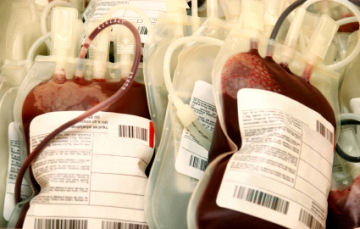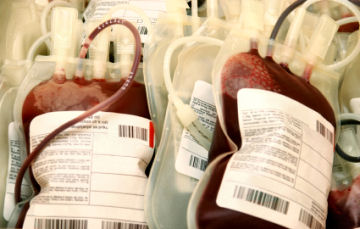Blood goes stale—and fairly quickly
Doctors have long thought it safe to store donated blood for up to 42 days, but some patients do better when the blood they receive is fewer than 14 days old.
After an accident, an ambulance arrives and rushes a patient to the hospital. Doctors realize the patient has lost too much blood and needs a donation of stored blood, called a transfusion. That blood comes from people who have voluntarily donated their own for emergencies or surgeries, so it’s ready when needed.
But how long can blood be safely stored before it’s no longer any good? Today, the government says hospitals can hold it for 42 days before it’s considered too old. The average age of blood used in transfusions is about 15 days. But new research shows even 15-day-old blood might be past its prime.
 |
|
The blood stored in these bags can save lives—but its useful shelf-life is shorter than researchers had realized. |
| iStockphoto |
Blood performs a crucial role in our bodies. It transports oxygen and other nutrients to cells and hauls off waste from those cells.
Previous research has shown that blood changes while it is in storage. But no studies had teased out whether these changes affect the people who receive the blood. In a new study, scientists at the Cleveland Clinic in Ohio examined hospital records of 6,002 people who received a transfusion of red blood cells after heart surgery. (Red blood cells carry and deliver oxygen around the body.) Almost half of the patients had been given new blood, less than 14 days old, and a little more than half had received blood older than 2 weeks. The scientists tracked the health records of the patients to check for any other differences.
By following what happened to the patients after the surgery, the scientists found that those who received the older blood had a higher chance of some serious problems. They were more likely to die in the hospital after the operation. Their kidneys didn’t function as well. They had more frequent occurrences of a blood disease called sepsis. And more of them died during the year after surgery.
Some changes in the blood might account for the health differences. Red blood cells that have been stored for too long start to lose the chemical that allows the cells to hand oxygen over to other cells in the body.
Also, scientists saw a difference in blood cell shape. After sitting in storage, cells link together to form long chains, “like miniature doughnuts stacked on one another,” says Eugene Blackstone, a doctor at the Cleveland Clinic. These doughnut-like chains might become too big to fit through capillaries, the smallest of blood vessels, and might therefore prevent the donated cells from reaching their targets.
The scientists caution that this study doesn’t give the final answer on the best storage time for blood. They say larger studies are necessary. But more than 5 million people in the United States receive blood transfusions each year. Studies such as this one may help those patients receive the healthiest blood possible.—Cynthia Graber
Power Words
From The American Heritage® Student Science Dictionary, The American Heritage® Children’s Science Dictionary, and other sources.
blood transfusion The transfer of blood from one person to another.
capillaries Tiny blood vessels that connect the smallest arteries to the smallest veins. Oxygen is delivered to, and carbon dioxide is removed from, the tissues of the body by means of the capillaries.
cells The most basic part of a living thing, made up of a jelly-like substance called cytoplasm that is enclosed by a thin membrane. The cells of plants and many-celled animals have a nucleus, which contains the genes and other structures.
oxygen A chemical element that is a colorless, odorless gas and that makes up about one-fifth of the Earth’s atmosphere. Oxygen is the most common element in the Earth’s crust, and it combines with other elements to form water, carbon dioxide, and iron ore. Oxygen is needed for plants and animals to live.
red blood cells A cell that is shaped like a disk and is found in the blood of humans and other vertebrates. Red blood cells contain hemoglobin, which carries oxygen to all the cells of the body and gives red blood cells their color.
 |
Copyright © 2002, 2003 Houghton-Mifflin Company. All rights reserved. Used with permission.
Going Deeper:
Seppa, Nathan. 2008. Bad blood? Old units might be substandard. Science News 173(March 22):179. Available at http://www.sciencenews.org/articles/20080322/fob1.asp .
To learn more about blood transfusions, visit www.kidshealth.org/teen/your_body/
medical_care/transfusions.html (KidsHealth for Teens).
You can play a blood-typing game online at www.nobelprize.org/educational_games/
medicine/landsteiner (Nobel Foundation).
Seppa, Nathan. 2007. Stored blood loses some of its punch. Science News 172(Oct. 27):269. Available at http://www.sciencenews.org/articles/20071027/note12.asp .
Wang, Linda. 2001. Blood relatives. Science News 159(March 31):206–207. Available at http://www.sciencenews.org/articles/20010331/bob16.asp .







